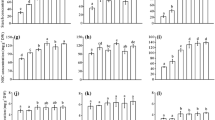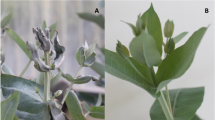Abstract
Data from field experiments carried out in three consecutive years under contrasting N supply and radiation environment altered by artificial shading were used to identify (a) the relationship between N concentration and organ size under conditions of unrestricted N supply and (b) critical levels of soil nitrate (Nmincrit), where nitrogen concentration of cauliflower organs begin to decline because of N limitations. The decline of N concentrations in cauliflower was analysed at different levels of morphological aggregation, i.e., the whole shoot level, the organ level (leaves, stem, and curd), and within different leaf groups within the canopy. Nmincrit values (0–60 cm soil depth) for total nitrogen concentration of cauliflower organs leaves, stem and curd were estimated at 85, 93 and 28 kg N ha−1, respectively. Within the canopy, Nmincrit values for total N of leaves increased from the top to the bottom from 44 to 188 kg N ha−1. Nmincrit values for protein N in leaves from different layers of the canopy were much lower at around 30 kg N ha−1, without a gradient within the canopy. It is discussed that these differences in Nmincrit values are most likely a consequence of N redistribution associated with nitrogen deficiency. The decline of average shoot nitrogen concentrations, [Nm] (%N DM), with shoot dry matter, W sh, (t ha−1) under conditions of optimal N supply was [Nm]= 4.84 (±0.071) W sh −0.089(± 0.011), r 2=0.67 (±S.E.). The reduction of radiation intensity by artificial shading (60% of control) had no significant influence on total nitrogen concentrations of leaves and only a small influence on protein nitrogen concentrations in lower layers of the canopy. The leaf nitrate nitrogen fraction of nitrogen, f nitr (–), within the canopy decreased linearly with increased average incident irradiance in different canopy layers (I av, W PAR m−2) (f Nitr. = 0.2456(±0.0188) – 0.0023(±0.0004)I av, r 2 = 0.67.
Similar content being viewed by others
References
Alt C 1999 Modelling nitrogen demand in cauliflower (Brassica oleracea L. botrytis) using productivity-nitrogen relationships. Ph.D. Thesis, Univ. Hannover, Hannover.
Alt C, Kage H and Stützel H 2000 Modelling nitrogen content and distribution in cauliflower (Brassica oleracea L. botrytis). Ann. Bot. 86, 963-973.
Barraclough P B 1986 The growth and activity of winter wheat roots in the field: nutrient inflows of high-yielding crops. J. Agric. Sci. (Camb.) 106, 53-59.
Cabin M and Yu 0 1984 Analysis of the time course of change in nitrogen content in Dactylis glomerata L. using a model of plant growth. Ann. Bot. 54, 143-157.
Colnenne C, Meynard J M, Reau R, Justes E and Merrien A 1998 Determination of a critical nitrogen dilution curve for winter oilseed rape. Ann. Bot. 81, 311-317.
De Willigen P and Van Noordwijk M 1987 Roots, plant production and nutrient use efficiency. Ph.D. Thesis, Agricultural University Wageningen.
Devienne-Barret F, Justes E, Machet J M and Mary B 2000 Integrated control of nitrate uptake by crop growth rate and soil nitrate availability under field conditions. Ann. Bot. 86, 995-1005.
Evans J R 1993 Photosynthetic acclimatisation and nitrogen partitioning within a Lucerne canopy. II. Stability trough time and comparison with a theoretical optimum. Aust. J. Plant Physiol. 20, 69-82.
Greenwood D J, Gastal F, Lemaire G, Draycott A, Millard P and Neeteson J J 1991 Growth rate and percent N of field grown crops-theory and experiments. Ann. Bot. 67, 181.
Greenwood D J, Lemaire G, Gosse G, Cruz P, Draycott A and Neeteson J 1990 Decline in percentage N of C3 and C4 Crops with increasing plant mass. Ann. Bot. 66, 425-436.
Hikosaka K, Terashima I and Katoh 5 1994 Effects of leaf age, nitrogen nutrition and photon flux density on the distribution of nitrogen among leaves of a vine (Ipomoea tricolor Cav.) grown horizontally to avoid mutual shading of leaves. Oecologia 97, 451-457.
Jamieson P D and Semenov M A 2000 Modelling nitrogen uptake and redistribution in wheat. Field Crops Res. 68, 21-29.
Justes E, Mary B, Meynard J M, Machet J M and Thelier-Huche L 1994 Determination of critical nitrogen dilution curve for winter wheat crops. Ann. Bot. 74, 397-407.
Kage H 1997 Is low rooting density of faba beans a cause of high residual nitrate content of soil at harvest? Plant Soil 190, 47-60.
Kage H, Alt C and Stutzel H 2001 Predicting dry matter production of cauliflower (Brassica oleracea L. botrytis) under unstressed conditions II. Comparison of light use efficiency and photosynthesis-respiration based model modules. Sci. Hortic. 87, 171-190.
Lemaire G and Gastal F 1997 Use of the nitrogen nutrition index for the analysis of agronomical data. In Diagnosis of the Nitrogen Status in Crops. Ed. G. Lemaire. pp. 45-55. Springer, Berlin, Heidelberg.
Lemaire G, Onillon B, Gosse G, Chartier M and Allirand J M 1991 Nitrogen distribution within a lucerne canopy during regrowth: relation with light distribution. Ann. Bot. 68, 483-488.
Makino A, Sato T, Nakano H and Mae T 1997 Leaf photosynthesis, plant growth and nitrogen allocation in rice under different irradiances. Planta 203, 390-398.
Palmer S J, Berridge D M, McDonald A J S and Davies W J 1996 Control of leaf expansion in sunflower (Helianthus annus L.) by nitrogen nutrition. J. Exp. Bot. 47, 359-368.
Peuke A D and Kaiser W M 1996 Nitrate or ammonium uptake and transport, and rapid regulation of nitrate reduction in higher plants. Prog. Bot. 57, 93-113.
Plenet D and Lemaire G 1999 Relationships between dynamics of nitrogen uptake and dry matter accumulation in maize crops. Determination of critical N concentration. Plant Soil 216, 65-82.
Rousseaux M C, Hall A J and Sanchez R A 1999 Light environment, nitrogen content and carbon balance of basal leaves of sunflower canopies. Crop Sci. 39, 1093-1100.
SAS Institute 1988 SAT/STAT User's Guide, Cary, NC.
Sheehy J E, Dionora M J A, Mitchell P L, Peng S, Cassman K G, Lemaire G and Williams R L 1998 Critical nitrogen concentrations: implications for high-yielding rice (Oryza sativa L.) cultivars in the tropics. Field Crops Res. 59, 31-41.
Stockle C O and Debaeke P 1997 Modeling crop nitrogen requirements: a critical analysis. Eur. J. Agron. 7, 161-169.
Vouillot M, Huet P and Boissard-P 1998 Early detection of N deficiency in a wheat crop using physiological and radiometric methods. Agronomie 18, 117-130.
Author information
Authors and Affiliations
Corresponding author
Rights and permissions
About this article
Cite this article
Kage, H., Alt, C. & Stützel, H. Nitrogen concentration of cauliflower organs as determined by organ size, N supply, and radiation environment. Plant and Soil 246, 201–209 (2002). https://doi.org/10.1023/A:1020627723616
Issue Date:
DOI: https://doi.org/10.1023/A:1020627723616




